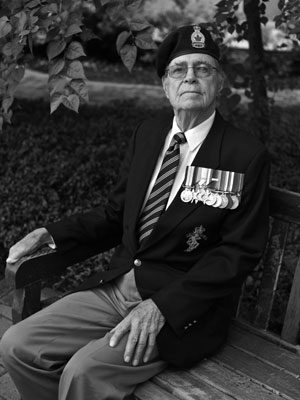Featuring photos by renowned Canadian photographer Yuri Dojc, and accompanied by interviews with the veterans, the book offers a reflective telling of their war experiences from a deeply personal perspective.
Here’s an excerpt from the book, in which three individuals each share their experience of living through the Second World War, as told to Sharon Henderson.

Adeline Messner b. September 30, 1923 Shamrock, Saskatchewan
With a clear memory, Adeline Messner recalls her intense desire, at the age of only 18, to contribute to the war effort. Originally refused enlistment due to health issues, Adeline bravely made her way to Hamilton, Ontario, to work in a weapon manufacturing plant. “It was wartime; we had to do what we could with what we had to offer.” With only minutes left on one of her 12-hour shifts, the lathe she was working on came down on her hand. Whether she fainted immediately before or after the accident was never known, but the shock truly set in when she woke up in the hospital with three and a half of her fingers gone. Adeline recalls knowing at that moment that her life was changed forever. For starters, she returned her engagement ring to her fiancé who was stationed nearby in London, Ontario. He showed up in person and told her to put the ring back on. Adeline and her husband went on to raise three boys and enjoy a 63-year marriage. Years later, Adeline humbly denies her injury as being worthy of recognition. But like many of the untold stories of women in wartime, Adeline’s contribution was given without asking for anything in return. Her heroism lies in her quiet nobility and her strength in carrying on.

Bill Royds b. April 11, 1922 Kenora, Ontario
Thinking back to his service as Ordinary Seaman on the frigate HMCS Saint John, Bill Royds fondly recalls his opportunity to travel around the world as a young man of only 19. “It was an incredible opportunity for a boy from northern Ontario,” he adds. And an exciting experience as well. Frigates were escort vehicles as well as being equipped for anti-submarine warfare, and the Saint John was heralded for the sinking of two German U-Boats in the English Channel near the coast of Scotland. Both the U-247 and the U-309 contained over 100 Germans and Bill can remember the exhilaration of the sailors when the hits were confirmed. “They were trying to kill us; it was our job to do the same. We sure celebrated,” says Bill. He also recalls the discipline of the navy as tough and life on the ship as difficult at times. “But we were young and proud to serve,” he remembers. “We weren’t there for the conditions; we were there for the cause.”

William Tindall b. January 13, 1923 Toronto, Ontario
With some creative talking, 17-year-old Bill Tindall successfully enlisted in the Governor General’s Horse Guards in 1940, keeping his true age hidden. Looking back he acknowledges that in his rush to join up, he lost his adolescence to war, but he adds, “life in the army was an education you can’t get anywhere else.” When his true age was discovered soon after, he was sent to a holding unit until his previous schooling in machine draughting came to light. At that point he was transferred to the Royal Canadian Engineers who were tasked with constructing hospitals, bases, roads and bridges in England to support the Allied forces. Eighteen days after the D-Day invasion of Normandy, Bill and his group arrived amongst “thousands of troops. And for every fighter on the front line, there were 10 in the background building, fixing or cooking,” he adds. In 1945, after victory was declared, Bill was transferred to the 3rd Canadian Cemetery Construction Company in Lille, France. His unit was responsible for ensuring Canadian soldiers who were killed in action and buried in make-shift graves or left on the battlefield received a proper burial in a Canadian cemetery. “When you see their graves,” Bill adds solemnly, “you realize these young men will forever miss life’s milestones. You get to go home and go on. Their sacrifice goes beyond what anyone should be asked to give.”
HONOUR will be published on November 3, 2010, and is available through chartwellreit.ca as well as at Chartwell Seniors Homes across Canada. Net proceeds of this book are being donated to Canadian organizations committed to the remembrance of Canada’s veterans including The War Amps Operation Legacy.